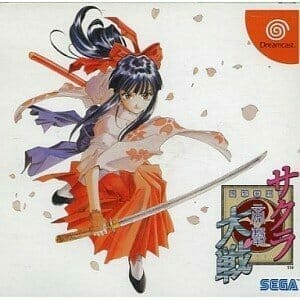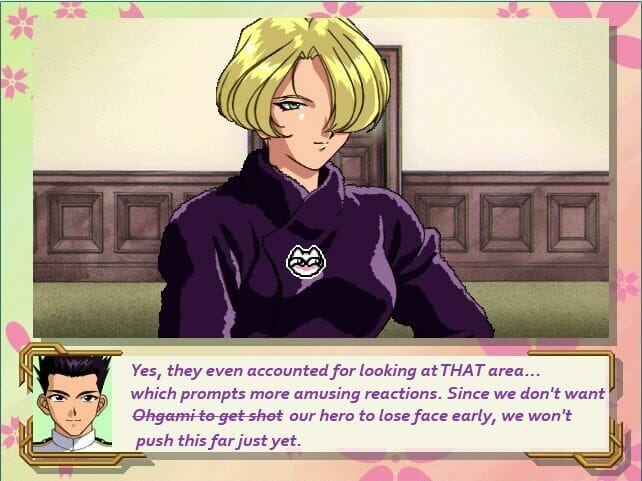 Before we begin the project proper, I’d like to give a bit of background on the very title we’ll be devoting an untold number of hours to in the next several months. Sakura Wars is a cross between a strategy RPG and a visual novel (read: dating sim) that is set in an alternate version of 1920s-era Japan. In this world, steam power gave society a kick in the pants, and led to the introduction of many modern conveniences. For many, peace has reigned since the great Kouma War of 1918, when the damned rose up against humanity and a massive demon appeared on the Nihon-bashi bridge. While the Imperia Army’s anti-demon team was able to defeat an seal the beast, the cost was high, and many lost their lives in the skirmish. In the years that followed, an international effort led to the formation of the Imperial Capital Defense Program and the Imperial Assault Troop as a measure to protect Japan from future supernatural threats. To even the odds, the military, partnering with Kanzaki Heavy Industries (this name becomes important, I swear!) to develop a robot powered not only by steam, but also by spiritual energy. During tests of the prototype, known as an “Oubu”, only one young girl was able to operate the device, which led to a misconception that only women could serve as pilots. And thus, the military began enlisting women from across the globe to join the force. The secret division was headquartered at the Grand Imperial Theater in the heart of Ginza. The division’s members were to lead double lives: in public, they were residents of the theater, and part of the Imperial Opera Troupe. It was believed that through the power of their songs, the troupe could suppress the looming evil in a traditional manner, and conquer their own demons on the battlefield of the stage to attain trust and confidence. Ichiro Ohgami is an ensign in the Imperial Navy, is summoned to take on the role of commander in the Imperial Assault Troop. Due to the secrecy of the operation, the only orders he has are to “go to Ueno Park.” Upon his arrival, though, he’s met by a young girl, rather than the usual military brass. Things get even more confusing as he’s led to a theater, and informed that his new duties involve clipping tickets and helping customers. While it’s hardly the type of job he was expecting, Ohgami needn’t worry about missing out on the action. A number of creatures of the night are poised and ready to strike Tokyo. They’re just waiting for the perfect moment.
Before we begin the project proper, I’d like to give a bit of background on the very title we’ll be devoting an untold number of hours to in the next several months. Sakura Wars is a cross between a strategy RPG and a visual novel (read: dating sim) that is set in an alternate version of 1920s-era Japan. In this world, steam power gave society a kick in the pants, and led to the introduction of many modern conveniences. For many, peace has reigned since the great Kouma War of 1918, when the damned rose up against humanity and a massive demon appeared on the Nihon-bashi bridge. While the Imperia Army’s anti-demon team was able to defeat an seal the beast, the cost was high, and many lost their lives in the skirmish. In the years that followed, an international effort led to the formation of the Imperial Capital Defense Program and the Imperial Assault Troop as a measure to protect Japan from future supernatural threats. To even the odds, the military, partnering with Kanzaki Heavy Industries (this name becomes important, I swear!) to develop a robot powered not only by steam, but also by spiritual energy. During tests of the prototype, known as an “Oubu”, only one young girl was able to operate the device, which led to a misconception that only women could serve as pilots. And thus, the military began enlisting women from across the globe to join the force. The secret division was headquartered at the Grand Imperial Theater in the heart of Ginza. The division’s members were to lead double lives: in public, they were residents of the theater, and part of the Imperial Opera Troupe. It was believed that through the power of their songs, the troupe could suppress the looming evil in a traditional manner, and conquer their own demons on the battlefield of the stage to attain trust and confidence. Ichiro Ohgami is an ensign in the Imperial Navy, is summoned to take on the role of commander in the Imperial Assault Troop. Due to the secrecy of the operation, the only orders he has are to “go to Ueno Park.” Upon his arrival, though, he’s met by a young girl, rather than the usual military brass. Things get even more confusing as he’s led to a theater, and informed that his new duties involve clipping tickets and helping customers. While it’s hardly the type of job he was expecting, Ohgami needn’t worry about missing out on the action. A number of creatures of the night are poised and ready to strike Tokyo. They’re just waiting for the perfect moment.
Impact
Sakura Wars was originally released on the Sega Saturn in 1996, and quickly became a cultural phenomenon in Japan. The title was an instant hit, as it moved over 360,000 copies in its first year of release. In addition to the usual array of action figures, OVAs, and soundtracks that accompany most hit games, it managed to reach outside of the gaming world to attract audiences normally associated with the hobby. In particular, the franchise spawned a highly successful series of stage shows, which still run to date, and feature various musical numbers from across the series. Sakura Wars was later re-released in 2000 on the Dreamcast and the PC, and remade for the PlayStation 2 in 2003. NIS America released Sakura Wars V in the west as Sakura Wars: So Long, My Love, which was hit stores in the latter half of 2010.
The Process
Before we begin, there are a two ways that this project can go:
- A straight-forward, no-frills translate and play-through
- A more laid-back and loose experience with commentary and jokes interspersed between dialogue, and requests for input on certain choices.
Either way, my goal is to have the game done fully by the end of the project. I won’t be doing anything to discredit the actual work going into this in either way, and commentary will be clearly noted in some form.With that in mind, what would you like to see from this? Feel free to leave your comments and chime in! Note: For this run, we’ll be using the PC version. I’ll be making attempts to translate the animated cut-scenes as needed, using annotations to provide subtitles. For example, let’s take a look at the intro cutscene:










